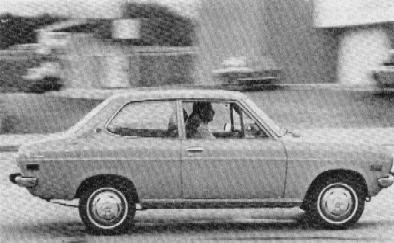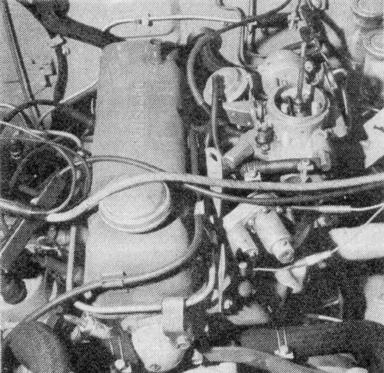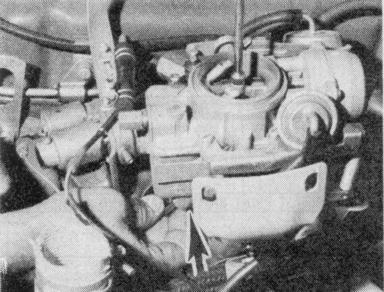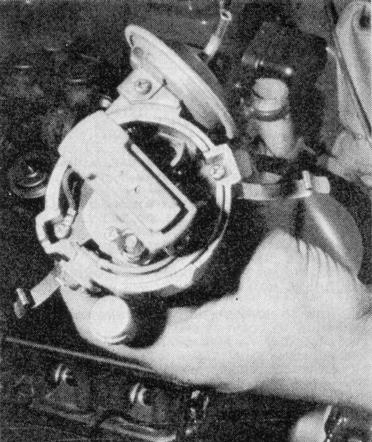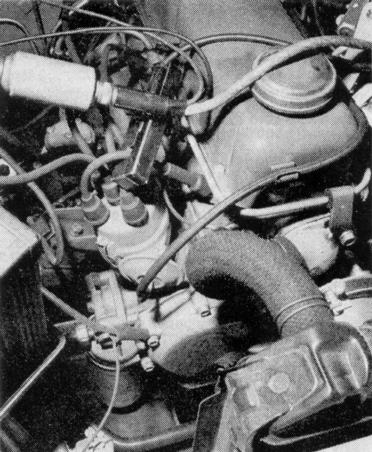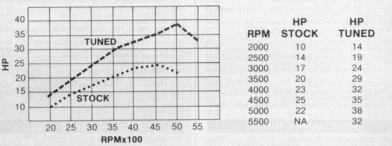| Revision as of 09:38, 6 June 2016 ddgonzal (Talk | contribs) (->Only 25) <- Previous diff |
Current revision ddgonzal (Talk | contribs) (->Baseline Tuning) |
||
| Line 1: | Line 1: | ||
| + | UPDATE: [http://www.latimes.com/local/obituaries/la-me-john-geraghty-20150603-story.html John Geraghty passed away] 27 May 2016. | ||
| + | |||
| <font face=arial size=-2>SUPERTUNE: Datsun 1200 | <font face=arial size=-2>SUPERTUNE: Datsun 1200 | ||
| <br>[Article from <i>Motor Trend</i> magazine, Nov 1973 issue pp. 142-144.]</font> | <br>[Article from <i>Motor Trend</i> magazine, Nov 1973 issue pp. 142-144.]</font> | ||
| Line 16: | Line 18: | ||
| But how does it fare in the stoplight sprints and the rush-hour grand prix? Although you might not think so at first look and possibly the first five minutes of driving, it does very well indeed, thank you. That little 1171-cc engine that lives under the short hood makes something like a Triumph Mark 1 Sprite engine look large by comparison, at least outwardly, but it has a surprise or two buried inside. For one thing, like the BLM A-type, or Sprite and Mini engine which it closely resembles, it has efficency that is unexpected from its rather ordinary design. For another, it is equipped with carburetion of a sort that has become normal wear for larger four-bangers but not the smaller, cheaper engines. This is the</font> | But how does it fare in the stoplight sprints and the rush-hour grand prix? Although you might not think so at first look and possibly the first five minutes of driving, it does very well indeed, thank you. That little 1171-cc engine that lives under the short hood makes something like a Triumph Mark 1 Sprite engine look large by comparison, at least outwardly, but it has a surprise or two buried inside. For one thing, like the BLM A-type, or Sprite and Mini engine which it closely resembles, it has efficency that is unexpected from its rather ordinary design. For another, it is equipped with carburetion of a sort that has become normal wear for larger four-bangers but not the smaller, cheaper engines. This is the</font> | ||
| - | <table border=1 bordercolor=black cellpadding=2 cellspacing=0><tr><td>[http://datsun1200.com/modules/myalbum/photo.php?lid=4967 http://datsun1200.com/modules/myalbum/photos/4967.jpg]</td><td width=50%></td></tr><tr><td><font face=arial size=-2><i>The Datsun 1200 or B-110 engine may be small, but like the BLM A-series engine used in the Mini and Midget, it has a lot of potential. A tuned 1200 can hang in there with the bigger 510 or 610 Datsun.</i></font></td><td></td></tr></table> | + | <table style="width:384px" border=1><tr><td>[http://datsun1200.com/modules/myalbum/photo.php?lid=4967 http://datsun1200.com/modules/myalbum/photos/4967.jpg]</td><td></td></tr><tr><td><font face=arial size=-2><i>The Datsun 1200 or B-110 engine may be small, but like the BLM A-series engine used in the Mini and Midget, it has a lot of potential. A tuned 1200 can hang in there with the bigger 510 or 610 Datsun.</i></font></td><td></td></tr></table> |
| <font face=arial size=-2>Stromberg-type progressive two-barrel unit found on such engines as the Subaru 1400 DL and the Honda Civic. It isn't readily apparent when you first get into the car because there is a definite detent feeling in the throttle between primary bore operation and the cutting in of the secondary throttle. As a result, it feels at first as though it were a single barrell carburetor and the detent point is all there is. A slightly stronger push on the throttle and one senses that it has suddenly developed about two more cylinders, similar in many respects to the operation of a Mazda when the secondary throttles and ports are opened. | <font face=arial size=-2>Stromberg-type progressive two-barrel unit found on such engines as the Subaru 1400 DL and the Honda Civic. It isn't readily apparent when you first get into the car because there is a definite detent feeling in the throttle between primary bore operation and the cutting in of the secondary throttle. As a result, it feels at first as though it were a single barrell carburetor and the detent point is all there is. A slightly stronger push on the throttle and one senses that it has suddenly developed about two more cylinders, similar in many respects to the operation of a Mazda when the secondary throttles and ports are opened. | ||
| Line 29: | Line 31: | ||
| We first checked the car out for its baseline tune and found only one thing wrong. It was equipped with Hitachi L 46 PW plugs which are extremely hot range, the equivalent of just above, say, an Autolite 52 series or even 62 if they made that range, or the hot AC 46 and 47 ranges and Champion N-8 and N-18. Most cars, as a contrast, are factory equipped two ranges colder and even that has, on occasion, proved a bit on the hot side. In any event two were blistered, one showed a heat-shock chip in the porcelain insulator and one had glaze and beginning blisters. Mileage on the clock was just over 5000. We exchanged the plugs for Autolite AG 42s, which are still pretty hot but the equivalent of many factory installations we've seen lately. Everything else checked as the book required so we put it on the rollers and started the checks. First was carburetion operation in primary cruise, primary power, secondary cruise and secondary power. The checks showed that the primary throttle functions of the carburetion were right on. Idle on this car gave an air/fuel ratio of 14.1/1 and readings of 1.7 percent carbon monoxide and 400 parts per million of hydrocarbons. Primary cruise, equivalent of steady-state driving in the 35 to 60 range, gave an air/fuel ratio of 14.3/1 and 1 percent Co and 200 ppm HC. The power phase, as expected, shot the air/fuel ratio 12.9 with a consequent</font> | We first checked the car out for its baseline tune and found only one thing wrong. It was equipped with Hitachi L 46 PW plugs which are extremely hot range, the equivalent of just above, say, an Autolite 52 series or even 62 if they made that range, or the hot AC 46 and 47 ranges and Champion N-8 and N-18. Most cars, as a contrast, are factory equipped two ranges colder and even that has, on occasion, proved a bit on the hot side. In any event two were blistered, one showed a heat-shock chip in the porcelain insulator and one had glaze and beginning blisters. Mileage on the clock was just over 5000. We exchanged the plugs for Autolite AG 42s, which are still pretty hot but the equivalent of many factory installations we've seen lately. Everything else checked as the book required so we put it on the rollers and started the checks. First was carburetion operation in primary cruise, primary power, secondary cruise and secondary power. The checks showed that the primary throttle functions of the carburetion were right on. Idle on this car gave an air/fuel ratio of 14.1/1 and readings of 1.7 percent carbon monoxide and 400 parts per million of hydrocarbons. Primary cruise, equivalent of steady-state driving in the 35 to 60 range, gave an air/fuel ratio of 14.3/1 and 1 percent Co and 200 ppm HC. The power phase, as expected, shot the air/fuel ratio 12.9 with a consequent</font> | ||
| - | <table border=1 bordercolor=black cellpadding=2 cellspacing=0><tr><td>[http://datsun1200.com/modules/myalbum/photo.php?lid=4968 http://datsun1200.com/modules/myalbum/photos/4968.jpg]<br><font face=arial size=-2><i>The main jets are set in wells in the bottom of the float bowl behind hex plugs. They can be removed without dismantling the carburetor by means of a short hex type slot-head screwdriver (arrow).</i></font></td><td width=50%></td></tr></table> | + | <table style="width:384px" border=1 bordercolor=black cellpadding=2 cellspacing=0><tr><td>[http://datsun1200.com/modules/myalbum/photo.php?lid=4968 http://datsun1200.com/modules/myalbum/photos/4968.jpg]<br><font face=arial size=-2><i>The main jets are set in wells in the bottom of the float bowl behind hex plugs. They can be removed without dismantling the carburetor by means of a short hex type slot-head screwdriver (arrow).</i></font></td><td></td></tr></table> |
| <font face=arial size=-2>increase in CO but little or none in HC, indicating an efficient burn. Secondary cruise was about the same as primary, indicating it was a bit lean for the added air and load. The power curve was pretty close to those of such cars as the Honda Civic, Subaru 1400 and Fiat 128, differing mainly in the higher speed ranges by being from four to five drive-wheel horsepower down which could be expected from a pushrod, non-crossflow head design. In any event the only problem we could see with the carburetion was that the secondary side was a touch on the lean side for full-load running. It also had the effect of pulling peak power down to 4500 rpm instead of the claimed 6000 or the expected 5000 rpm, as can be seen by the chart and the graph, due to leaning out at the top end. | <font face=arial size=-2>increase in CO but little or none in HC, indicating an efficient burn. Secondary cruise was about the same as primary, indicating it was a bit lean for the added air and load. The power curve was pretty close to those of such cars as the Honda Civic, Subaru 1400 and Fiat 128, differing mainly in the higher speed ranges by being from four to five drive-wheel horsepower down which could be expected from a pushrod, non-crossflow head design. In any event the only problem we could see with the carburetion was that the secondary side was a touch on the lean side for full-load running. It also had the effect of pulling peak power down to 4500 rpm instead of the claimed 6000 or the expected 5000 rpm, as can be seen by the chart and the graph, due to leaning out at the top end. | ||
| Line 39: | Line 41: | ||
| The carburetion was the first point to get attention. For some reason, the last two cars to get the treatment and the Datsun all use the same carburetors or at least the same type. The jets in this particular carburetor are reached through diagonally placed ports in the bottom of the float chamber. There are two brass hex plugs that are removed and then the jets can be reached by means of a stubby hex-shaft screwdriver. It was a tight reach on the other two, but on the Datsun it's a piece of cake. Only the secondary jet was removed and replaced with one with only a slightly larger but different shaped orifice. That was the only change, though we were informed that certain other 1200s required a larger primary as well -- which is one reason why kit customers are asked for the exact year, model and engine number when ordering ... for any car, not just the Datsun. | The carburetion was the first point to get attention. For some reason, the last two cars to get the treatment and the Datsun all use the same carburetors or at least the same type. The jets in this particular carburetor are reached through diagonally placed ports in the bottom of the float chamber. There are two brass hex plugs that are removed and then the jets can be reached by means of a stubby hex-shaft screwdriver. It was a tight reach on the other two, but on the Datsun it's a piece of cake. Only the secondary jet was removed and replaced with one with only a slightly larger but different shaped orifice. That was the only change, though we were informed that certain other 1200s required a larger primary as well -- which is one reason why kit customers are asked for the exact year, model and engine number when ordering ... for any car, not just the Datsun. | ||
| - | <table border=1 bordercolor=black cellpadding=2 cellspacing=0><tr><td><font face=arial size=-2><i>The distributor is up at the left front of the engine and is easily removed for modification. It is geared so that the rotor position should be marked before removal.<br>[http://datsun1200.com/modules/myalbum/photo.php?lid=4970 http://datsun1200.com/modules/myalbum/photos/4970.jpg]<br>distributor with cap off</i></font></td><td width=50%></td></tr></table> | + | <table style="width:372px" border=1><tr><td><font face=arial size=-2><i>The distributor is up at the left front of the engine and is easily removed for modification. It is geared so that the rotor position should be marked before removal.<br>[http://datsun1200.com/modules/myalbum/photo.php?lid=4970 http://datsun1200.com/modules/myalbum/photos/4970.jpg]<br>distributor with cap off</i></font></td></tr></table> |
| <font face=arial size=-2> The ignition, which carries just one set of points, was removed and placed on the strobe. The rotor and breaker plate were removed, exposing the advance weights and springs. The only change made was the replacement of secondary spring (the one that is loosest) with one from th ekit. This procedure keeps the primary part of the ignition curve standard but quickens the secondary part so that it peaks nearer the point of peak torque and just above the tip-in point of the secondary throttle. The breaker plate was reinstalled and the points set by the dwell meter to give 51-degree dwell. This part is critical and in all cases of this sort, the points should be set</font> | <font face=arial size=-2> The ignition, which carries just one set of points, was removed and placed on the strobe. The rotor and breaker plate were removed, exposing the advance weights and springs. The only change made was the replacement of secondary spring (the one that is loosest) with one from th ekit. This procedure keeps the primary part of the ignition curve standard but quickens the secondary part so that it peaks nearer the point of peak torque and just above the tip-in point of the secondary throttle. The breaker plate was reinstalled and the points set by the dwell meter to give 51-degree dwell. This part is critical and in all cases of this sort, the points should be set</font> | ||
| - | <table border=1 bordercolor=black cellpadding=2 cellspacing=0><tr><td>[http://datsun1200.com/modules/myalbum/photo.php?lid=4969 http://datsun1200.com/modules/myalbum/photos/4969.jpg] | + | <table style="width:372px" border=1 bordercolor=black cellpadding=2 cellspacing=0><tr><td>[http://datsun1200.com/modules/myalbum/photo.php?lid=4969 http://datsun1200.com/modules/myalbum/photos/4969.jpg] |
| <br><font face=arial size=-2><i>distributor on engine</i></font></td><td width=50%></td></tr></table> | <br><font face=arial size=-2><i>distributor on engine</i></font></td><td width=50%></td></tr></table> | ||
| Line 54: | Line 56: | ||
| The power at the rear wheels was up significantly from the bottom of the curve to the top and peak power now came on with 38 indicated horse at the expected 5000 rpm and at 5500 rpm it was still pulling 10 horses more than it had previously at 5000. The chart shows the numbers and graph gives an indication of how the numbers came in. | The power at the rear wheels was up significantly from the bottom of the curve to the top and peak power now came on with 38 indicated horse at the expected 5000 rpm and at 5500 rpm it was still pulling 10 horses more than it had previously at 5000. The chart shows the numbers and graph gives an indication of how the numbers came in. | ||
| - | <blockquote><table border=1 bordercolor=black cellpadding=2 cellspacing=0><tr><td><font face=arial size=-2><i>The ignition is of the single point set variety. The breaker plate is simple to take out and only one spring needs to be changed. It is mandatory to set point gap by dwell rather than by feeler gauge.</i></font> | + | <blockquote><font face=arial size=-2><i>The ignition is of the single point set variety. The breaker plate is simple to take out and only one spring needs to be changed. It is mandatory to set point gap by dwell rather than by feeler gauge.</i></font></blockquote> |
| - | </td><td width=50%></td></tr></table></blockquote> | + | |
| Back on the street, the added power at the bottom end wasn't especially noticeable until 3500 rpm, though it made itself apparent by a smoother take-off. It was the secondary tip-in in the lower gears that gave the clue that something was different. The conjunction of the quickened advance and the air/fuel curve now matched better, giving a more efficent burn and the difference was one that could be felt and even seen. Getting onto freeways was no problem, other than making sure the car wasn't exceeding the traffic flow speed. Moving over into faster lanes was easier and quicker and on one hill over the Santa Monica mountains where it would formerly do about 45 in third gear, it would run up to above 55 mph, being limited mainly by the scrub-off speed in the turns. The action and feeling was nearer a well-tuned 1600cc car, such as a Colt or Big Brother 510, rather than a 1200. Mileage suffered not at all expect in the top end in secondary power, the problem being that it was no longer satisfying to remain in low cruise because booting it was such fun. | Back on the street, the added power at the bottom end wasn't especially noticeable until 3500 rpm, though it made itself apparent by a smoother take-off. It was the secondary tip-in in the lower gears that gave the clue that something was different. The conjunction of the quickened advance and the air/fuel curve now matched better, giving a more efficent burn and the difference was one that could be felt and even seen. Getting onto freeways was no problem, other than making sure the car wasn't exceeding the traffic flow speed. Moving over into faster lanes was easier and quicker and on one hill over the Santa Monica mountains where it would formerly do about 45 in third gear, it would run up to above 55 mph, being limited mainly by the scrub-off speed in the turns. The action and feeling was nearer a well-tuned 1600cc car, such as a Colt or Big Brother 510, rather than a 1200. Mileage suffered not at all expect in the top end in secondary power, the problem being that it was no longer satisfying to remain in low cruise because booting it was such fun. | ||
| Line 63: | Line 64: | ||
| <br> | <br> | ||
| <br> | <br> | ||
| - | For further information, write Geraghty Automotive and Marine, 4062 Verdugo Rd., Los Angelese, CA 90065.</font> | + | For further information, write [http://www.latimes.com/local/obituaries/la-me-john-geraghty-20150603-story.html Geraghty Automotive and Marine], 4062 Verdugo Rd., Los Angeles, CA 90065.</font> |
| - | <table border=1 bordercolor=black cellpadding=2 cellspacing=0><tr><td> | + | <table style="width:392px" border=1 bordercolor=black cellpadding=2 cellspacing=0><tr><td>[http://datsun1200.com/modules/myalbum/photo.php?lid=4971 http://datsun1200.com/modules/myalbum/photos/4971.jpg] |
| - | [http://datsun1200.com/modules/myalbum/photo.php?lid=4971 http://datsun1200.com/modules/myalbum/photos/4971.jpg] | + | <br><font face=arial size=-2><i>dyno graph of stock (25 horsepower) versus tuned engine (38 horsepower)</i></font></td></tr></table> |
| - | <br><font face=arial size=-2><i>dyno graph of stock (25 horsepower) versus tuned engine (38 horsepower)</i></font> | + | |
| - | </td></tr></table> | + | |
| </font></TD><TD></TD></TR></TABLE> | </font></TD><TD></TD></TR></TABLE> | ||
| Line 84: | Line 83: | ||
| Compare this with the real-world Corolla 1200 rear-wheel-horsepower dyno figures: | Compare this with the real-world Corolla 1200 rear-wheel-horsepower dyno figures: | ||
| - | <table width=300 border=1 bordercolor=black cellpadding=2 cellspacing=0> | + | <table class="wiki_table" width=300 border=1 bordercolor=black cellpadding=2 cellspacing=0> |
| <tr bgcolor=ccccff><td>RPM</td><td>Standard Corolla 1200</td><td> | <tr bgcolor=ccccff><td>RPM</td><td>Standard Corolla 1200</td><td> | ||
| Buckle S Corolla</td></tr><tr><td>4400</td><td>22.4</td> | Buckle S Corolla</td></tr><tr><td>4400</td><td>22.4</td> | ||
| Line 109: | Line 108: | ||
| So what was all this Corolla upgrade gear good for? | So what was all this Corolla upgrade gear good for? | ||
| - | <table border=1 bordercolor=black cellpadding=2 cellspacing=0> | + | <table class="wiki_table" border=1 bordercolor=black cellpadding=2 cellspacing=0> |
| <tr bgcolor=ccccff><td>Spec</td><td>Standard Corolla 1200 | <tr bgcolor=ccccff><td>Spec</td><td>Standard Corolla 1200 | ||
| </td><td>Buckle S Corolla</td></tr><tr><td>Top Speed</td> | </td><td>Buckle S Corolla</td></tr><tr><td>Top Speed</td> | ||
| Line 117: | Line 116: | ||
| <td>31 mpg</td><td>32.3 mpg</td></tr></table> | <td>31 mpg</td><td>32.3 mpg</td></tr></table> | ||
| As you can see, all this work did NOT make the Corolla 1200 a fast car, but according to the testers it sounded more "savage" than the Escort GS's "prowl growl". | As you can see, all this work did NOT make the Corolla 1200 a fast car, but according to the testers it sounded more "savage" than the Escort GS's "prowl growl". | ||
| + | |||
| + | = Baseline Tuning = | ||
| + | Here's what you can do to Supertune your A engine: | ||
| + | |||
| + | IGNITION | ||
| + | * make sure the [[Ignition_Timing#Setting_Dwell|dwell]] is correct (49-51 degrees) | ||
| + | *: Dwell is set every 3,000 miles per Nissan maintenance schedule | ||
| + | |||
| + | * Set [[Spark_Curve#Setting_Total_Timing|total timing]] to 32 degrees (A12) or 34 degrees (A14/A15) | ||
| + | |||
| + | * Remove one of [[Spark_Curve#Changing_Mechanical_Advance|the distributor springs]] so advance occurs sooner | ||
| + | |||
| + | CARBURETOR | ||
| + | * Check that [[Inspecting_Distributor#Inspect Vacuum Advance|the vacuum advance works]]. This increases power at low throttle openings (great for street engines, not important for race engines) | ||
| + | |||
| + | * Ensure there are [[Vacuum_Leaks#Engine_Off_Inspection|no vacuum leaks]] which lean out your carburetor | ||
| + | |||
| + | * Inspect the [[Float Level Adjustment|Carburetor Float]]. Adjust if not spot-on | ||
| + | |||
| + | * [[Carburetor Adjustment|Adjust the carburetor]] | ||
| + | |||
| + | These FREE processes will gain HP over the average-condition A engine. | ||
| + | |||
| + | = Dyno-Tune Kit = | ||
| + | Geraghty Dyno-Tune Kit is the brainchild of John Geraghty, who runs a small tune-up shop in Los Angeles. | ||
| + | |||
| + | Naples Daily News June 4, 1972 | ||
| + | |||
| + | 419kb download | ||
| + | <br>[http://i297.photobucket.com/albums/mm219/ddgonzal/Datsun%201200/wiki/64567033.jpg http://i297.photobucket.com/albums/mm219/ddgonzal/Datsun%201200/wiki/th_64567033.jpg] | ||
| [[Category:Engine Modifications]] | [[Category:Engine Modifications]] | ||
| [[Category:Tech Section]] | [[Category:Tech Section]] | ||
| [[Category:Magazine Articles]] | [[Category:Magazine Articles]] | ||
Current revision
UPDATE: John Geraghty passed away 27 May 2016.
SUPERTUNE: Datsun 1200
[Article from Motor Trend magazine, Nov 1973 issue pp. 142-144.]
|
SUPERTUNE: Datsun 1200 By John Christy Everyone is aware of the potential of the Datsun 510 and 610 cars, both as street machines and racers (although Datsun has stopped trumpeting its race wins to the world). There is also Baby Brother, the little 1200, also known as the 100 -- and please no comments about the 1:10 morning milk train. The 1200 is becoming equally well publicized, this time for its miserliness in the use of precious gasoline. Depending on whose tests you like, Motor Trend's or the EPA's, it is either second-best or best in the country for miles traveled on a gallon of fuel.
Stromberg-type progressive two-barrel unit found on such engines as the Subaru 1400 DL and the Honda Civic. It isn't readily apparent when you first get into the car because there is a definite detent feeling in the throttle between primary bore operation and the cutting in of the secondary throttle. As a result, it feels at first as though it were a single barrell carburetor and the detent point is all there is. A slightly stronger push on the throttle and one senses that it has suddenly developed about two more cylinders, similar in many respects to the operation of a Mazda when the secondary throttles and ports are opened.
increase in CO but little or none in HC, indicating an efficient burn. Secondary cruise was about the same as primary, indicating it was a bit lean for the added air and load. The power curve was pretty close to those of such cars as the Honda Civic, Subaru 1400 and Fiat 128, differing mainly in the higher speed ranges by being from four to five drive-wheel horsepower down which could be expected from a pushrod, non-crossflow head design. In any event the only problem we could see with the carburetion was that the secondary side was a touch on the lean side for full-load running. It also had the effect of pulling peak power down to 4500 rpm instead of the claimed 6000 or the expected 5000 rpm, as can be seen by the chart and the graph, due to leaning out at the top end.
The ignition, which carries just one set of points, was removed and placed on the strobe. The rotor and breaker plate were removed, exposing the advance weights and springs. The only change made was the replacement of secondary spring (the one that is loosest) with one from th ekit. This procedure keeps the primary part of the ignition curve standard but quickens the secondary part so that it peaks nearer the point of peak torque and just above the tip-in point of the secondary throttle. The breaker plate was reinstalled and the points set by the dwell meter to give 51-degree dwell. This part is critical and in all cases of this sort, the points should be set
by dwell rather than by guess or feeler gauge since improper point setting can negate much of the effect and also affect the car's emissions.
The ignition is of the single point set variety. The breaker plate is simple to take out and only one spring needs to be changed. It is mandatory to set point gap by dwell rather than by feeler gauge. Back on the street, the added power at the bottom end wasn't especially noticeable until 3500 rpm, though it made itself apparent by a smoother take-off. It was the secondary tip-in in the lower gears that gave the clue that something was different. The conjunction of the quickened advance and the air/fuel curve now matched better, giving a more efficent burn and the difference was one that could be felt and even seen. Getting onto freeways was no problem, other than making sure the car wasn't exceeding the traffic flow speed. Moving over into faster lanes was easier and quicker and on one hill over the Santa Monica mountains where it would formerly do about 45 in third gear, it would run up to above 55 mph, being limited mainly by the scrub-off speed in the turns. The action and feeling was nearer a well-tuned 1600cc car, such as a Colt or Big Brother 510, rather than a 1200. Mileage suffered not at all expect in the top end in secondary power, the problem being that it was no longer satisfying to remain in low cruise because booting it was such fun.
|
... Page 3 to be continued ...
Only 25
Story recap by ddgonzal
Only 25 horsepower? Yes, 25 horsepower!
Now you know how the old hp ratings were pure fantasy. The factory's 69 hp figure for the Datsun 1200 was not the relatively accurate SAE NET rating that we have now. Instead it was based on a "gross" flywheel HP ratings (for more information, see our article Overview of Datsun 1200 HP and Performance").
Compare this with the real-world Corolla 1200 rear-wheel-horsepower dyno figures:
| RPM | Standard Corolla 1200 | Buckle S Corolla |
| 4400 | 22.4 | 32.7 |
| 4700 | 24.9 | 35.8 |
| 5000 | 26.8 | 40.0 |
| 5500 | 23.6 | 41.5 |
| 6000 | 21.9 | 43.3 |
| 6300 | 15.0 | 42.8 |
26.8 horsepower! from the Corolla 1200 on the Hunter and Delbridge dynomometer.
You can also see how well the Corolla horsepower increased but more importantly the entire power band was extended into the high rpm ranges.The Corolla had probably around $1500 worth of upgrades (in today's dollars):
- head ported and polish
- extractor exhaust (tubular headers)
- carburetor adjustments
- open-element air filter
- distributor adjustments
- Fleetwing 100 petrol (high octane gasoline)
- dyno tuning
So what was all this Corolla upgrade gear good for?
| Spec | Standard Corolla 1200 | Buckle S Corolla |
| Top Speed | 87 mph | 95 mph |
| 1/4 mile | 19.3 sec | 18.5 |
| 0-60 mph | 14.4 sec | 12.9 sec |
| Fuel | 31 mpg | 32.3 mpg |
As you can see, all this work did NOT make the Corolla 1200 a fast car, but according to the testers it sounded more "savage" than the Escort GS's "prowl growl".
Baseline Tuning
Here's what you can do to Supertune your A engine:
IGNITION
- make sure the dwell is correct (49-51 degrees)
- Dwell is set every 3,000 miles per Nissan maintenance schedule
- Set total timing to 32 degrees (A12) or 34 degrees (A14/A15)
- Remove one of the distributor springs so advance occurs sooner
CARBURETOR
- Check that the vacuum advance works. This increases power at low throttle openings (great for street engines, not important for race engines)
- Ensure there are no vacuum leaks which lean out your carburetor
- Inspect the Carburetor Float. Adjust if not spot-on
These FREE processes will gain HP over the average-condition A engine.
Dyno-Tune Kit
Geraghty Dyno-Tune Kit is the brainchild of John Geraghty, who runs a small tune-up shop in Los Angeles.
Naples Daily News June 4, 1972

![[Datsun 1200 encyclopedia]](/wiki/upload/wiki.png)
